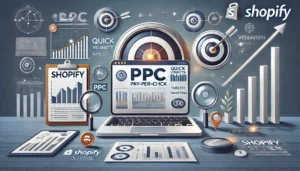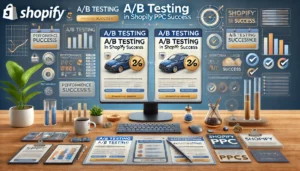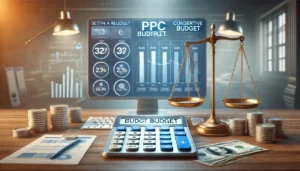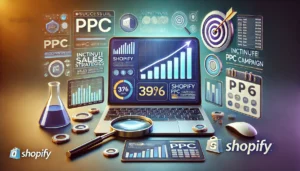Shopify PPC Success: Tips and Tricks for UK Store Owners

Shopify PPC Success: Tips and Tricks for UK Store Owners Just Like You! Pay-Per-Click (PPC) advertising can significantly boost traffic and sales for Shopify store owners in the UK. By understanding PPC basics, setting up effective campaigns, and continuously optimising efforts, store owners can achieve remarkable results. This article provides essential tips and tricks for mastering PPC, from keyword research to budget management.
Shopify PPC Success: Key Takeaways
- PPC advertising is a powerful tool for increasing traffic and sales for Shopify stores.
- Understanding and using the right keywords is crucial for PPC success.
- Effective ad copy can greatly improve the performance of your PPC campaigns.
- Regularly monitoring and adjusting your PPC budget is essential for optimal results.
- Utilising advanced strategies like retargeting and automation can significantly boost your PPC efforts.
Understanding the Basics of Shopify PPC Success
What is PPC and How Does it Work?
PPC, or Pay-Per-Click, is an online advertising model where advertisers pay a fee each time their ad is clicked. It’s a way to buy visits to your site, rather than attempting to earn those visits organically. For Shopify store owners, PPC can be a quick and effective method to drive targeted traffic and boost sales. The most common platforms for PPC are Google Ads and Facebook Ads. Google Ads allows your ads to appear on search engine results pages, while Facebook Ads target users based on their interests and behaviours.
The Importance of PPC for Shopify Stores
PPC is crucial for Shopify stores because it provides almost instant visibility and traffic. Unlike SEO, which can take months to show results, PPC campaigns can start driving traffic as soon as they go live. This is particularly beneficial for new stores looking to establish a presence quickly. Moreover, PPC allows for precise targeting, enabling you to reach your ideal customers based on demographics, location, and even the time of day. This level of targeting ensures that your ads are seen by the people most likely to convert.
Common PPC Terms Every Store Owner Should Know
Understanding PPC terminology is essential for managing your campaigns effectively. Here are some key terms:
- CPC (Cost Per Click): The amount you pay each time someone clicks on your ad.
- CTR (Click-Through Rate): The percentage of people who click on your ad after seeing it.
- Quality Score: A metric used by Google to determine the relevance and quality of your ads.
- Ad Rank: Determines the position of your ad on the search engine results page.
- Conversion Rate: The percentage of users who complete a desired action, such as making a purchase, after clicking on your ad.
By mastering these terms, you’ll be better equipped to optimise your PPC campaigns and achieve better results.
In summary, understanding the basics of PPC is the first step towards running successful campaigns for your Shopify store. From knowing what PPC is and how it works, to recognising its importance and familiarising yourself with common terms, these fundamentals will set you on the path to success.
Shopify PPC Success: Setting Up Your First Shopify PPC Campaign
Choosing the Right PPC Platform
Selecting the right platform is crucial. Google Ads and Facebook Ads are popular choices. Google Ads are great for reaching users actively searching for products. On the other hand, Facebook Ads excel in targeting specific demographics and interests. Choosing the right platform can make or break your campaign.
Defining Your Campaign Goals
Before diving in, we need to define clear, measurable goals. Are we aiming to increase traffic, boost sales, or generate leads? Knowing our objectives helps us tailor our strategy and measure success. It’s essential to have a roadmap.
Creating Effective Ad Copy
Crafting compelling ad copy is an art. We should focus on creating messages that resonate with our target audience. Use strong calls to action and highlight unique selling points. Remember, the goal is to grab attention and drive clicks. A/B testing different versions can help us find the most effective copy.
Setting up a PPC campaign might seem daunting, but with the right approach, it can be a game-changer for your Shopify store.
Keyword Research for Shopify PPC Success
Identifying High-Intent Keywords
When it comes to PPC, not all keywords are created equal. We need to focus on high-intent keywords that signal a strong likelihood of conversion. These are the search terms that potential customers use when they are ready to make a purchase. For example, instead of targeting a broad keyword like “shoes,” we might target “buy running shoes online.” This approach helps in reducing customer acquisition cost (CAC) and ensures that our ads reach the right audience.
Using Keyword Research Tools
Keyword research tools are essential for finding the best keywords for our campaigns. Tools like Google Keyword Planner, SEMrush, and Ahrefs can provide valuable insights into search volume, competition, and keyword trends. By leveraging these tools, we can identify which keywords are worth bidding on and which ones to avoid. Using these tools effectively can make a significant difference in our PPC success.
Incorporating Long-Tail Keywords
Long-tail keywords are longer and more specific keyword phrases that visitors are more likely to use when they are closer to making a purchase. These keywords often have lower search volumes but higher conversion rates. For instance, instead of targeting “laptops,” we might target “best laptops for graphic design.” Incorporating long-tail keywords into our PPC strategy can help us attract more qualified traffic and improve our overall campaign performance.
By carefully considering factors such as short-term vs. long-term goals, targeting demographics, keyword research, analysing ad performance data, and adjusting our strategies accordingly, we can create a comprehensive marketing plan that utilises both SEO and PPC to their full potential.
In summary, effective keyword research is the backbone of any successful Shopify PPC campaign. By identifying high-intent keywords, using keyword research tools, and incorporating long-tail keywords, we can optimise our ads for better performance and achieve our marketing goals.
Optimising Your PPC Ads for Better Performance
Shopify PPC Success: A/B Testing Your Ads
A/B testing is a powerful way to find out what works best for your audience. We can test different versions of our ads to see which one performs better. This includes testing headlines, descriptions, and calls-to-action (CTAs). By comparing the results, we can make data-driven decisions to improve our ads.
Improving Ad Quality Scores
Ad quality scores are crucial for the success of our PPC campaigns. A higher quality score can lead to lower costs and better ad placements. To improve our scores, we need to focus on relevance, landing page experience, and click-through rates (CTR). Regularly conducting a Google ads audit can help us identify areas for improvement.
Utilising Ad Extensions
Ad extensions provide additional information and make our ads more visible. We can use site links, callouts, and structured snippets to enhance our ads. These extensions not only increase the size of our ads but also make them more engaging. For example, adding a “Shop Now” button can encourage users to take action.
Regularly reviewing and optimising our PPC campaigns is key to success. By tracking performance and making data-driven adjustments, we can improve our results and achieve our goals.
Targeting the Right Audience with PPC
Demographic Targeting Strategies
Understanding your audience is key to effective PPC campaigns. Demographic targeting allows us to reach potential customers based on age, gender, income, and more. For instance, if our Shopify store sells high-end fashion, targeting higher income brackets can be beneficial. Knowing who your customers are helps in crafting ads that resonate with them.
Interest-Based Targeting
Interest-based targeting is another powerful tool. By focusing on users’ interests and online behaviours, we can show our ads to people who are more likely to be interested in our products. This method is particularly useful for niche markets. For example, if we sell eco-friendly products, targeting users interested in sustainability can yield better results.
Geographic Targeting for UK Store Owners
For UK store owners, geographic targeting is essential. We can focus our ads on specific regions, cities, or even postcodes. This is especially useful for local businesses or those offering region-specific promotions. By narrowing down our audience geographically, we ensure our ads are seen by people who can actually make a purchase.
Effective targeting is crucial for PPC success. It ensures our ads reach the right people, maximising our return on investment.
Managing Your PPC Budget Effectively
Setting a Realistic Budget
Setting a realistic budget is crucial for the success of your PPC campaigns. We need to balance what we can afford with what is possible in the marketplace. Determining the right budget can be tricky, especially for new accounts without historical data. It’s often a good idea to start with a conservative budget and adjust as we gather more data.
Bid Management Tips
Effective bid management is key to maximising our return on investment. We should consider using automated bid strategies offered by platforms like Google Ads. These tools can help us get more traffic to our company website by optimising bids based on real-time data. Manual bidding can also be effective if we have a deep understanding of our market.
Shopify PPC Success: Monitoring and Adjusting Your Spend
Regularly monitoring and adjusting our spend is essential. We should track key metrics such as click-through rate (CTR), conversion rate, and cost per click (CPC). By analysing this data, we can make informed decisions and adjust our budget accordingly. This ongoing process helps us ensure that our campaigns remain effective and cost-efficient.
Consistent monitoring and adjustment of our PPC budget can lead to significant improvements in campaign performance.
In summary, managing our PPC budget effectively involves setting a realistic budget, employing smart bid management strategies, and continuously monitoring and adjusting our spend. By following these steps, we can optimise our PPC management efforts and achieve better results for our Shopify store.
Leveraging Google Shopping Ads for Shopify
Setting Up Google Shopping Campaigns
To get started with Google Shopping Ads, we need to connect our Shopify store to Google Merchant Centre. This involves setting up a product feed that sends our product data to Google. We can use a Shopping Feed App within Shopify for this purpose. Once our products are in Google Merchant Centre, we can link it to our Google Ads account and create our first Shopping campaign. It’s crucial to ensure our product data is accurate and up-to-date to avoid any disapprovals.
Optimising Product Listings
Optimising our product listings is key to success with Google Shopping Ads. We should focus on creating detailed and compelling product titles and descriptions. Including high-quality images and competitive pricing can also make a big difference. Additionally, we should regularly review and update our product data to keep it relevant and appealing to potential customers.
Tracking Performance Metrics
Tracking the performance of our Google Shopping Ads is essential to understand what works and what doesn’t. We should monitor key metrics such as click-through rates (CTR), conversion rates, and return on ad spend (ROAS). Using these insights, we can make data-driven decisions to improve our campaigns. Utilising analytics tools can help us keep track of these metrics and make necessary adjustments to optimise our ad performance.
Shopify PPC Success: Using Retargeting to Boost Conversions
Understanding Retargeting
Retargeting is a powerful strategy that shows ads to users who have already visited your site but didn’t make a purchase. This keeps your brand fresh in their minds and encourages them to return and complete their purchase. By using retargeting, we can increase the number of touchpoints with potential customers, making it more likely they’ll convert.
Setting Up Retargeting Campaigns
To set up a retargeting campaign, you’ll need to create a remarketing audience. This can be done through platforms like Google Ads or Google Analytics. Here’s a simple step-by-step guide:
- Go to your Google Ads account and navigate to the ‘Audiences’ section.
- Click on ‘Create Audience’ and select ‘Website Visitors’.
- Define the criteria for your audience, such as users who visited specific pages or took certain actions.
- Save your audience and use it in your retargeting campaigns.
Measuring Retargeting Success
It’s crucial to track the performance of your retargeting campaigns to ensure they’re effective. Key metrics to monitor include:
- Click-through rate (CTR)
- Conversion rate
- Cost per conversion
By analysing these metrics, we can make data-driven decisions to optimise our campaigns and achieve better results.
Retargeting is not just about bringing users back to your site; it’s about engaging them in a meaningful way that leads to conversions.
Analysing and Reporting on PPC Campaigns
Key Metrics to Track
To understand the success of our PPC campaigns, we need to monitor key metrics. These include click-through rate (CTR), conversion rate, cost per click (CPC), and return on ad spend (ROAS). Tracking these metrics helps us see what’s working and what needs improvement.
Using Analytics Tools
We can use various analytics tools to gather data on our campaigns. Google Analytics and other platforms provide insights into user behaviour and ad performance. These tools are essential for making data-driven decisions.
Making Data-Driven Decisions
By analysing the data, we can make informed decisions to optimise our campaigns. Adjusting bids, refining keywords, and tweaking ad copy based on performance data can lead to better results. Remember, continuous improvement is key to PPC success.
Regular analysis and reporting are crucial for understanding and improving PPC campaigns. They help us stay on top of trends and make necessary adjustments for better performance.
Avoiding Common PPC Mistakes
Overcoming Ad Fatigue
Ad fatigue happens when your audience sees the same ad too many times, causing them to lose interest. To combat this, we should rotate our ads regularly. Fresh content keeps the audience engaged and improves click-through rates. Additionally, using different ad formats can help maintain interest.
Avoiding Keyword Overlap
Keyword overlap occurs when multiple ads from the same campaign compete for the same keyword. This can drive up costs and reduce effectiveness. To avoid this, we need to carefully organise our keyword lists and use negative keywords to prevent internal competition. Tools like Google Keyword Planner can assist in identifying and managing overlaps.
Ensuring Ad Relevance
Ad relevance is crucial for maintaining a high-quality score and improving ad performance. We must ensure that our ad copy closely matches the keywords and the landing page content. This alignment not only boosts our quality score but also enhances user experience, leading to better conversion rates.
By focusing on these common pitfalls, we can optimise our PPC campaigns and achieve better results.
Advanced Strategies for Shopify PPC Success
Utilising Automation Tools
Automation tools can save us time and improve our PPC campaigns. By using these tools, we can automate bidding, ad placements, and even ad copy adjustments. This allows us to focus on strategy rather than manual tasks. Automation tools can also help us identify trends and make data-driven decisions quickly.
Implementing Dynamic Remarketing
Dynamic remarketing is a powerful way to re-engage visitors who have shown interest in our products. By showing them personalised ads based on their browsing history, we can increase the chances of conversion. This strategy keeps our brand top-of-mind and encourages users to return and complete their purchase.
Exploring New PPC Channels
While Google Ads and Facebook are popular, exploring new PPC channels can give us an edge. Platforms like Pinterest, LinkedIn, and even TikTok offer unique opportunities to reach different audiences. By diversifying our PPC efforts, we can find untapped markets and potentially lower our advertising costs.
Regularly track your content performance and adjust your strategy based on the insights. What works for one business may not work for another, so finding what resonates best with your audience is important.
In conclusion, advanced strategies like automation, dynamic remarketing, and exploring new channels can significantly boost our PPC success. Let’s leverage these tactics to stay ahead in the competitive ecommerce landscape.
Mastering Shopify PPC can be a game-changer for your online store. With the right strategies, you can boost traffic, increase sales, and grow your brand. Want to see how your current PPC campaigns are doing? Get a free, human review of your ads performance today!
Conclusion on Shopify PPC Success
In conclusion, mastering PPC for your Shopify store can significantly boost your online presence and sales. By following the tips and tricks outlined in this article, UK store owners can create effective PPC campaigns that drive targeted traffic and increase conversions. Remember, the key to success lies in continuous monitoring and optimisation. Keep testing different strategies, analysing your results, and making data-driven adjustments. With dedication and the right approach, your Shopify store can thrive in the competitive e-commerce landscape. Happy advertising!
Shopify PPC Success Frequently Asked Questions
What is PPC and how does it work?
PPC, or Pay-Per-Click, is a type of online advertising where you pay each time someone clicks on your ad. It helps drive traffic to your website quickly.
Why is PPC important for Shopify stores?
PPC is crucial for Shopify stores because it can attract more visitors and potential customers to your site, leading to increased sales.
What are some common PPC terms I should know?
Some common PPC terms include CPC (Cost Per Click), CTR (Click-Through Rate), and ROI (Return on Investment). These help you understand and measure your campaign’s success.
How do I choose the right PPC platform?
Choosing the right PPC platform depends on your target audience. Google Ads is great for search intent, while Facebook Ads can target specific demographics and interests.
What are high-intent keywords?
High-intent keywords are search terms that indicate a user is ready to make a purchase or take a specific action. They are crucial for effective PPC campaigns.
How can I improve my PPC ad’s performance?
You can improve your PPC ad’s performance by A/B testing different versions of your ads, using high-quality images, and adding clear calls to action.
What is retargeting and how does it help?
Retargeting shows ads to people who have already visited your site but didn’t make a purchase. It helps remind them of your products and encourages them to return and buy.
How do I avoid common PPC mistakes?
To avoid common PPC mistakes, regularly update your keyword list, monitor your ad performance, and make sure your ads are relevant to your target audience.
Author
Search Blog
Free PPC Audit
Subscribe to our Newsletter
The Voices of Our Success: Your Words, Our Pride
Don't just take our word for it. With over 100+ five-star reviews, we let our work-and our satisfied clients-speak for us.
"We have been working with PPC Geeks for around 6 months and have found Mark and the team to be very impressive. Having worked with a few companies in this and similar sectors, I rate PPC Geeks as the strongest I have come across. They have taken time to understand our business, our market and competitors and supported us to devise a strategy to generate business. I value the expertise Mark and his team provide and trust them to make the best recommendations for the long-term."
~ Just Go, Alasdair Anderson





